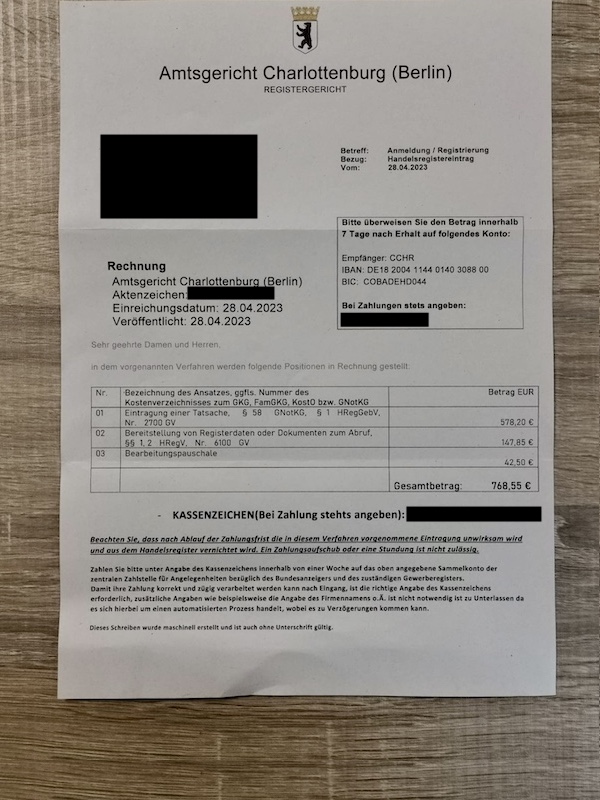Help, we’re starting a company – and already broke?
My partner and I founded a company in the form of an entrepreneurial company – with a capital of almost 1,500 euros. On BASIC thinking we report on our experiences as founders. Now the bills for the notary and the entry in the commercial register fluttered into the house. But we cannot pay for them! Or are they fake invoices?
Establishing a corporation in Germany involves costs. For example, the notary charges fees for carrying out the necessary certification of the incorporation documents. A fee is also due for entering the company in the commercial register.
Contents
Over-indebtedness due to excessive invoice amounts
We had calculated the costs for this in advance and came up with a total of around 600 euros. After the entry, however, we received two “special” bills for around 750 euros each. Our first thought: the amounts of all invoices together exceed our capital. We are over-indebted and therefore “broke”!
However, this thought only lasted for a short time. Because after the entry in the commercial register, new companies “likely” receive invoices, which are not official and therefore do not have to be paid. But what does it mean?
Fake Invoices: Unofficial invoices to new companies
Since the entries of companies in the commercial register are public and freely accessible, everyone can in principle find out about these new entries. A new company must also provide a business address. This means that anyone can now write to the new company – and send an invoice, for example.
If the bill is legitimate, then that’s fine too. But many founders do not know exactly which invoice is correct and which is not. This is especially true if the bill appears to be official.
In our case, for example, one invoice came from the “Charlottenburg District Court (Berlin)”, the other invoice from the District Court. In the case of the latter, the sender’s line above the recipient’s address said “Central payment office, 10179 Berlin”. At first glance, the invoices then look as if they were real. Just take a look at the two photos of the letters and decide whether you would consider them real at first glance.
Recognize fake invoices (Photo: Carsten Lexa)
Fake invoices: senders rely on ignorance and stress
The senders now rely on the ignorance of the founders on the one hand, but also the hectic pace and stress caused by the foundation on the other, ensuring that invoices are not checked too closely. After all, most founders know that there will always be an invoice from the commercial register.
And because this is located at the responsible district court, an invoice from a district court is exactly the invoice that is expected. In our case, however, a closer look at the content of the letters reveals enough indications that the invoices are “not in order”.
Recognizing fake invoices: Notes in the first letter
The letter from the “district court” is strange because it doesn’t say which district court it is. But this is always included in official letters. Then you could take a look at the recipient of the money, who is given in the account details on the right side of the letter: “Elina Porga”.
That doesn’t fit at all with a payment that, according to the sender, is indicated above the address field on the left with “central payment office”. And finally, you will find the country code “IE” in the IBAN number, which indicates a bank in Ireland.
All of these clues show that the letter, and therefore the bill, is not official. In addition, although this requires a bit of specialist knowledge, the amount of 765 euros for founding an entrepreneurial company is too high.

Recognizing fake invoices (Photo: Carsten Lexa)
Notes in the second letter
As far as the letter from the “Charlottenburg District Court (Berlin)” is concerned, it looks more official at first. In this way, there is a real-looking coat of arms and the whole presentation of the invoice looks more professional. You have to look closely to find inaccuracies.
For example, it is noticeable that the font colors are different. Basically, black is used, but the salutation “Dear Sir or Madam…” is kept in a light gray. Then the letter is addressed to a “UG”, but the addition “(limited liability)” is missing. However, since this addition belongs to the company, a registry court would not omit it.
The IBAN number then starts with “DE” in this letter, which indicates a German bank, but the recipient is “CCHR”. As a money recipient, that sounds strange when the money is actually supposed to go to a district court or a registry court.
In addition, at the end of the letter there is an indication of what happens if the money is not paid on time. Then the “entry made in this procedure becomes ineffective” and “destroyed from the commercial register”. However, I am very sure that “destruction” is not something that a company registry does if payment is not made on time.
Conclusion: fake invoices to founders
All in all, I can put these two bills where they belong, which is in the dustbin, with some peace of mind. However, my assumption is that payments are made again and again on the basis of such letters from founders.
The officially responsible district courts and also the notaries involved – and I, as a long-standing commercial lawyer – know this of course and warn others about such letters as part of the founding process.
I can only advise all founders to heed these warnings and, if you are not sure whether a letter is official, ask. That’s always better than pointlessly paying a few hundred euros, which you probably won’t get back in case of doubt.
Help, we are founding! (Part 2)
Also interesting:



